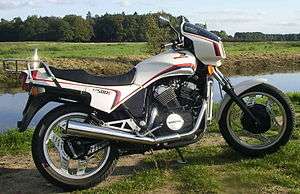Honda VT500
VT500 is a common name for the family of Honda motorcycles sharing the VT500 inline V-twin engine. Launched at the Cologne motorcycle show in September 1982, it was produced with various designations for different countries, such as Ascot, Shadow and Euro.

Design parameters
Conventional V twin engines often had the fore and aft cylinders set at 90-degrees to reduce the primary engine vibration, which in turn created a bulky, long engine requiring a long-wheelbase frame.
Honda briefed their engineers to produce a compact, inline V twin engine with any angle narrower than 90 degrees, but leaving enough space between the cylinders to locate conventional carburetors with the airbox located under the fuel tank, to maintain a slim-profile without side-facing carburetors associated with some marques. The optimal design was found to be with the cylinder angle set at 52 degrees, but additionally having offset crankpins to achieve acceptable levels of vibration reduction without the need for additional balancing shafts which would have added weight and reduced power. The narrow-V engine was compact and at the time was one of the lightest and narrowest, enabling a frame design offering good manoeuvrability.[1]
Specification
The engine is a 491cc liquid-cooled inline V-twin 4 stroke. The cylinders are splayed 52 degrees apart with a crankshaft that has its throws offset, allowing engine characteristics of closer to 76 degrees, to achieve the lower primary vibration levels close to a 90-degree V-twin.[1]
Developments
The VT500 is also the base for the later NTV, NT, VRX and XLV engines ranging from 400 to 750 cc.
References
- Motor Cycle News 22 September 1982, pp.1, 3, 27-29 Special issue, Europe's biggest bike show. Accessed and added 2015-03-08